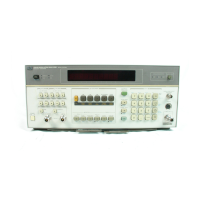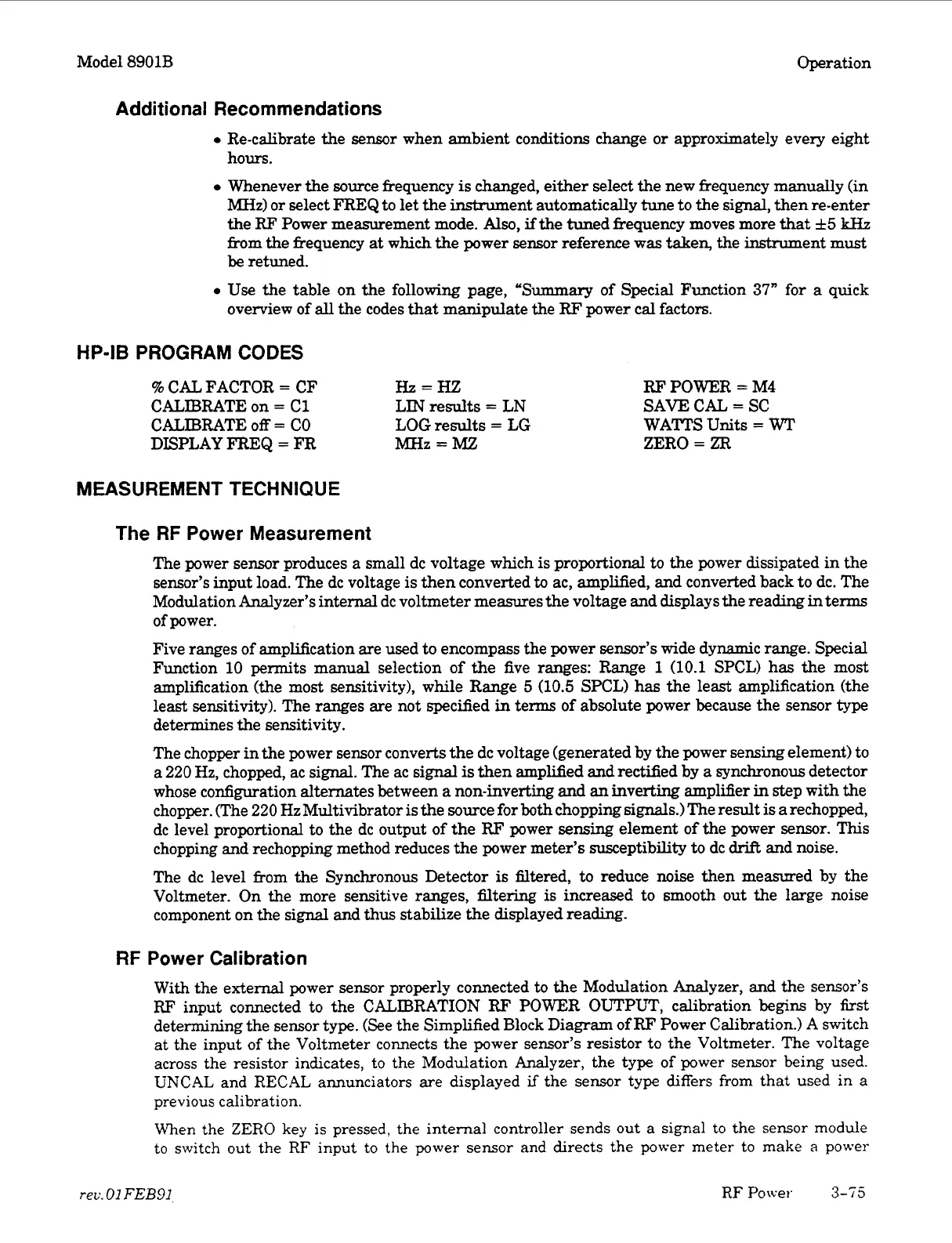Model 8901B Operation
Additional Recommendations
0
Re-calibrate the
sensor
when ambient conditions change
or
approximately every eight
hours.
0
Whenever
the
source frequency
is
changed, either select the new frequency manually
(in
MHz)
or
select FREQ
to
let the
instrum
ent automatically tune to the signal, then re-enter
the
RF
Power measurement mode.
Also,
if
the
tuned frequency moves more
that
&5
Hz
&om
the
frequency
at
which
the
power
sensor
reference was
taken,
the
instrum
ent must
be
retuned.
0
Use
the table on the following page,
“Summary
of Special Function
37”
for
a
quick
overview of
all
the codes
that
manipulate the
RF
power cal factors.
HP-IB PROGRAM
CODES
%
CAL FACTOR
=
CF
Hz=m
RF
POWER
=
M4
CALIBRATE on
=
C1
LIN
results
=
LN
CALIBRATE
off
=
CO
LOG
results
=
LG
DISPLAY FREQ
=
FR
hlHz=MZ
ZERO
=
ZR
SAVE CAL
=
SC
WATTS
Units
=
WT
MEASUREMENT TECHNIQUE
The
RF
Power Measurement
The power sensor produces
a
small dc voltage which
is
proportional
to
the power dissipated
in
the
sensor’s input load. The dc voltage
is
then converted
to
ac, amplified, and converted back to dc. The
Modulation Analyzer’s internal dc voltmeter measures the voltage and displays the rea-
in
terms
of
power.
Five ranges of amplification are used to encompass the power
sensor’s
wide dynamic range.
Special
Function 10 permits manual selection of the five ranges: Range
1
(10.1 SPCL) has the most
amplification (the most sensitivity), while Range
5
(10.5 SPCL)
has
the least amplification (the
least
sensitivity).
The ranges are not specified
in
terms of absolute power because the sensor
type
determines the sensitivity.
The chopper in the power sensor converts the dc voltage (generated by the power sensing element) to
a
220
Hz,
chopped,
ac
signal.
The
ac
signal
is
then amplified and rectified by
a
synchronous detector
whose configuration alternates between
a
non-inverting
and
an
inverting amplifier
in
step with the
chopper. CThe
220
Hz Multivibrator
is
the source for both chopping
signals.)
The result
is
a
rechopped,
dc level proportional to the dc output
of
the
RF
power
sensing
element of the power
sensor.
This
chopping and rechopping method reduces the power meter’s susceptibility to dc
drift
and noise.
The dc level from the Synchronous Detector
is
filtered, to reduce noise then measured by the
Voltmeter. On the more sensitive ranges, filtering
is
increased to smooth out the large noise
component on the signal and
thus
stabilize
the
displayed
reading.
RF
Power Calibration
With
the external power
sensor
properly connected to the Modulation Analyzer, and the sensor’s
FU?
input connected to the CALIBRATION
RF
POWER OUTPUT, calibration begins by
first
determining the sensor
type.
(See the Simplified Block Diagram of
FW
Power Calibration.)
A
switch
at the input
of
the Voltmeter connects the power sensor’s resistor
to
the Voltmeter. The voltage
across the resistor indicates, to the Modulation Analyzer, the
type
of
power sensor being used.
UNCAL
and
RECAL
annunciators are displayed
if
the sensor type differs from that used in a
previous calibration.
When the
ZERO
key
is
pressed, the internal controller sends out
a
signal
to
the
sensor
module
to
switch out
the
RF
input to the power sensor and directs the power meter to make
a
power
rec.01
FEBSI
RF
Power
3-75

